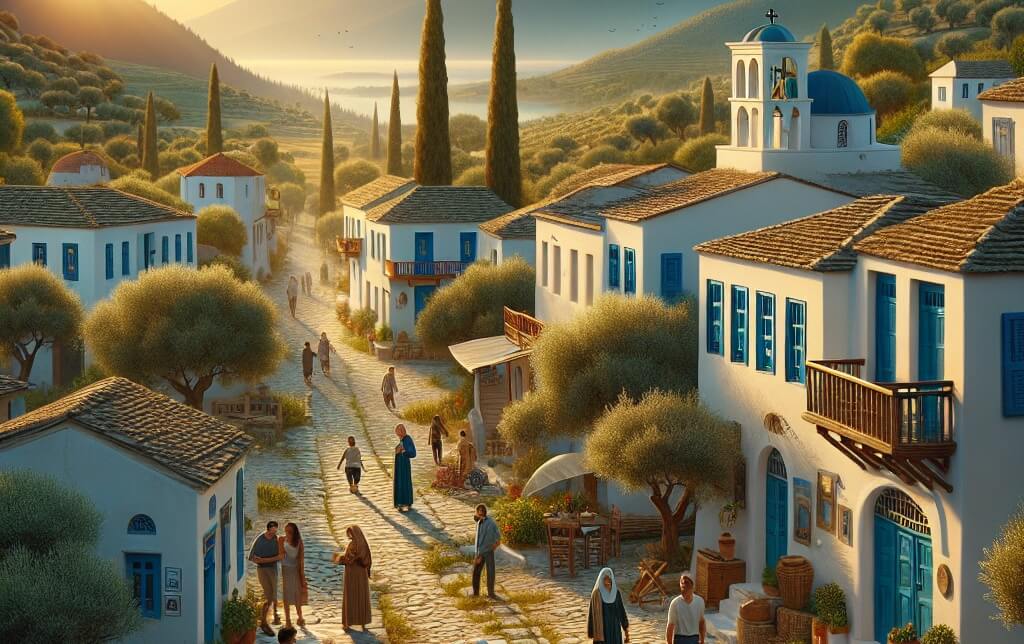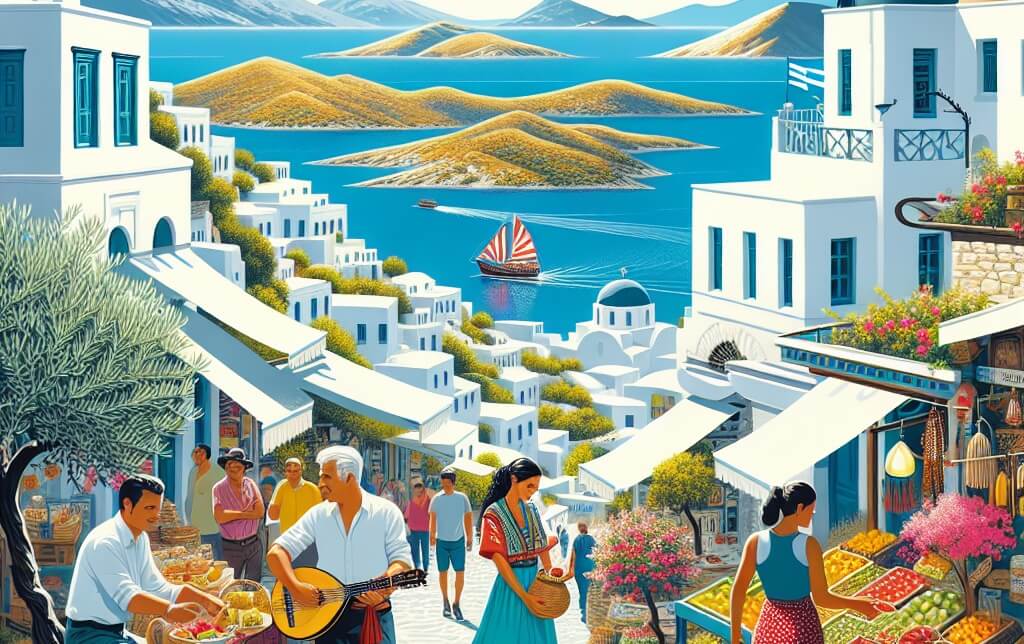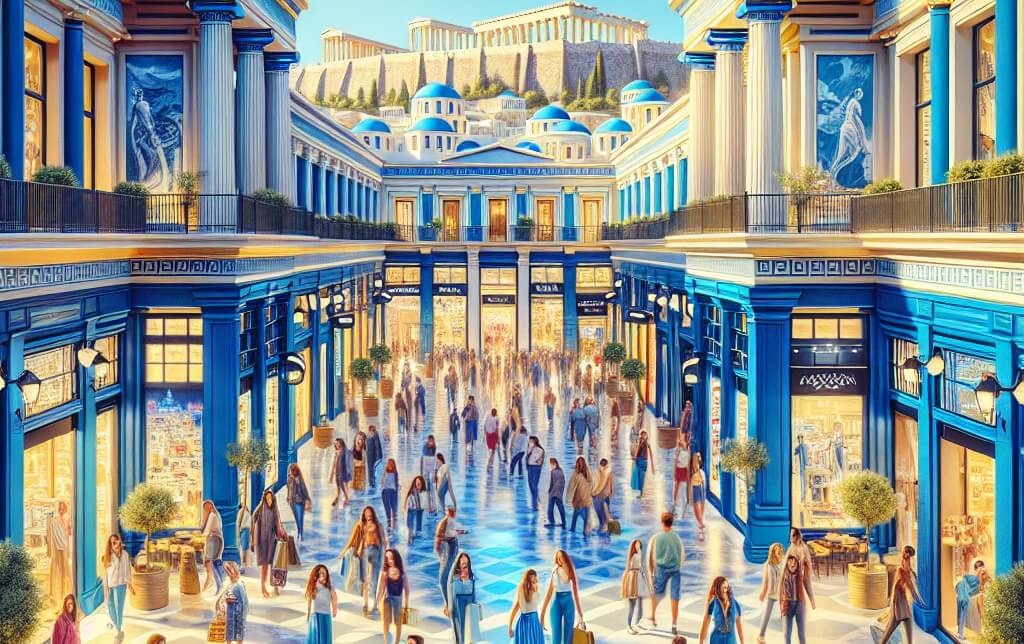
Discover Kamara Thessaloniki, Greece - A Historic Landmark
Kamara Thessaloniki in Greece stands as a significant historic landmark that captivates visitors with its rich cultural heritage and architectural beauty. This iconic structure, also known as the Arch of Galerius, dates back to the 4th century AD and serves as a testament to the city's illustrious past. The intricate design and grandeur of Kamara reflect the architectural prowess of the Roman Empire and offer a glimpse into the ancient history of Thessaloniki. Visitors can immerse themselves in the ambiance of this historic site, marvel at its imposing presence, and appreciate the craftsmanship that has withstood the test of time. Kamara Thessaloniki is a must-visit destination for those seeking to explore the historical treasures of Greece and experience the allure of a bygone era.
Introduction
The city of Thessaloniki, located in northern Greece, is a vibrant and historically significant destination that attracts visitors from around the world. Known for its rich cultural heritage, stunning architecture, and bustling waterfront, Thessaloniki offers a unique blend of ancient and modern attractions. Kamara, a historic triumphal arch built in the 4th century AD, stands as a symbol of the city's past glory and resilience. As visitors explore the streets of Thessaloniki, they will encounter a wealth of archaeological sites, museums, and vibrant neighborhoods that showcase the city's diverse and dynamic character. With its warm Mediterranean climate, delicious cuisine, and welcoming locals, Thessaloniki is a must-visit destination for those seeking a truly immersive cultural experience in Greece.
Overview of Kamara Thessaloniki and its significance in Greece.
Kamara Thessaloniki, also known as the Arch of Galerius, is a historical monument located in the city of Thessaloniki, Greece. Constructed in the 4th century AD by the Roman Emperor Galerius, Kamara is a triumphal arch that served as a commemoration of his victory over the Persians. The significance of Kamara in Greece lies in its architectural and historical importance, showcasing the influence of Roman culture in the region. It stands as a testament to the rich heritage of Thessaloniki and serves as a reminder of the city's ancient past. Kamara Thessaloniki is not only a symbol of architectural prowess but also a cultural landmark that attracts tourists and historians alike, contributing to the cultural identity and historical significance of Greece.
Historical Background
The historical background of Kamara, Thessaloniki, Greece, is rich and significant. Kamara, also known as the Arch of Galerius, is a triumphal arch that was built in the 4th century AD by the Roman Emperor Galerius. It served as a monumental entrance to the city of Thessaloniki and symbolized the power and glory of the Roman Empire. The architectural style of Kamara reflects the influence of both Roman and Byzantine cultures, making it a unique and important historical landmark in Thessaloniki. Over the centuries, Kamara has witnessed numerous historical events and has stood as a testament to the city's rich and diverse past. Today, Kamara continues to attract visitors from around the world who are eager to explore its historical significance and architectural beauty.
Discuss the historical context of Kamara Thessaloniki and its importance in ancient times.
Kamara Thessaloniki, located in Greece, holds significant historical importance dating back to ancient times. Constructed in the 4th century AD, Kamara is a triumphal arch that served as a gateway to the city of Thessaloniki. It was built by the Roman Emperor Galerius to commemorate his victory over the Persians. The arch's intricate architecture and grandeur reflect the prosperity and power of the Roman Empire during that period. Kamara also symbolizes the cultural and architectural influence of the Romans in the region. In addition to its historical significance, Kamara Thessaloniki has stood the test of time and serves as a tangible link to the past, allowing visitors to connect with the rich history of the area.
Roman Era
The Roman Era refers to the period in ancient history when the Roman Empire held significant influence over vast territories, including the region of Thessaloniki, Greece. During this time, Thessaloniki, known as Kamara, played a crucial role as a key strategic and commercial hub within the empire. The Roman presence in the city is evident through architectural marvels such as the Kamara arch, a triumphal arch built to commemorate the Roman Emperor Galerius. This period marked a time of prosperity and cultural exchange, as Thessaloniki flourished as a center of trade, art, and intellectual pursuits under Roman rule. The legacy of the Roman Era can still be observed in the archaeological remains and historical sites that dot the landscape of modern-day Thessaloniki, serving as a testament to the enduring impact of this ancient civilization.
Construction of Kamara Thessaloniki during the 4th century AD.
The construction of Kamara Thessaloniki during the 4th century AD marked a significant architectural achievement in the ancient city of Thessaloniki, Greece. The Kamara, also known as the Arch of Galerius, was built to commemorate the victory of the Roman Emperor Galerius over the Persians. The structure, with its intricate carvings and imposing archway, served as a symbol of Roman power and authority in the region. Constructed using a combination of brick and marble, the Kamara stood as a testament to the grandeur and engineering prowess of the Roman Empire. Its strategic location at the intersection of major thoroughfares in Thessaloniki ensured its prominence as a focal point of the city's urban landscape. The construction of the Kamara Thessaloniki exemplifies the architectural sophistication and cultural significance of the Roman era in Greece.
Role of the arch in the Eastern City and its connection to Roman Emperor Galerius.
The role of the arch in the Eastern City, specifically in Thessaloniki, Greece, holds significant historical and architectural importance. The Kamara, a triumphal arch built in the 4th century AD, is a notable example of this architectural feature. It is closely connected to the Roman Emperor Galerius, who commissioned its construction as a commemoration of his military victories. The arch served as a symbolic entrance to the city, marking the transition between the Roman Forum and the Imperial Palace. Its intricate design and elaborate decorations reflect the power and grandeur of the Roman Empire during that period. The Kamara stands as a lasting testament to the influence of Roman architecture in the Eastern City and its connection to the reign of Emperor Galerius.
Depiction of scenes on the marble panels of Kamara Thessaloniki.
The marble panels adorning the Kamara Thessaloniki in Greece depict a rich array of scenes that capture the historical and cultural essence of the region. These intricately carved panels showcase a variety of motifs, including mythological figures, architectural elements, and symbolic representations of significant events. The craftsmanship and attention to detail evident in these depictions reflect the skilled artistry of the craftsmen who created them. Each panel tells a unique story, offering viewers a glimpse into the past and providing a visual narrative of the city's heritage. The scenes portrayed on the marble panels of Kamara Thessaloniki serve as a testament to the artistic and cultural legacy of this iconic landmark.
Architectural Features
The architectural features of Kamara in Thessaloniki, Greece, are characterized by their historical significance and unique design elements. Kamara, also known as the Arch of Galerius, is a triumphal arch that was built in the 4th century AD to commemorate the Roman Emperor Galerius' victory over the Persians. The arch is constructed of brick and marble, with intricate carvings and reliefs depicting scenes from ancient mythology and military conquests. The grandeur of Kamara's architecture reflects the power and prestige of the Roman Empire during that time period. Today, Kamara stands as a prominent landmark in Thessaloniki, serving as a testament to the city's rich history and cultural heritage.
Explore the architectural characteristics of Kamara Thessaloniki.
Kamara, located in Thessaloniki, Greece, is an architectural marvel that showcases a blend of Byzantine and Ottoman influences. This historic arch, also known as the Arch of Galerius, stands as a testament to the city's rich cultural heritage. The structure features intricate carvings, detailed reliefs, and ornate decorations that reflect the craftsmanship of its time. The use of brick and marble in its construction adds to its grandeur and durability, symbolizing the architectural prowess of the era. Kamara's distinct octagonal shape and the intricate patterns adorning its facade make it a significant landmark in Thessaloniki, serving as a reminder of the city's diverse history and architectural evolution.
Design and Structure
When considering the design and structure of Kamara in Thessaloniki, Greece, it is essential to acknowledge the historical significance and architectural beauty of this iconic landmark. Kamara, also known as the Arch of Galerius, was constructed in the 4th century AD to commemorate the victory of the Roman Emperor Galerius over the Persians. The design of Kamara showcases a blend of Roman and Greek architectural styles, with intricate carvings and decorative elements that reflect the grandeur of the era. The structure itself consists of four main columns supporting a central arch, creating a striking visual focal point in the city. The meticulous attention to detail and craftsmanship in the design of Kamara exemplifies the enduring legacy of ancient Greek and Roman architecture in Thessaloniki.
Description of the central arched opening and its significance.
The central arched opening of Kamara in Thessaloniki, Greece, serves as a prominent architectural feature that holds significant historical and cultural value. This grand arched entrance, constructed in the 4th century AD, is a symbol of the city's rich Roman heritage and its importance as a major hub of the Byzantine Empire. The meticulous design and intricate detailing of the arch reflect the skilled craftsmanship of the era, showcasing the architectural prowess of the time. Furthermore, the arched opening also serves as a gateway to the city, welcoming visitors with its imposing presence and serving as a reminder of Thessaloniki's enduring legacy as a center of trade, culture, and history in the region.
Height and width of Kamara Thessaloniki.
The Kamara of Thessaloniki, located in Greece, stands as a significant historical monument in the city. The structure, commonly known as the Arch of Galerius, boasts a height of approximately 15 meters and a width of around 8.3 meters. This impressive triumphal arch, built in the early 4th century AD to commemorate the victory of the Roman Emperor Galerius over the Persians, showcases intricate architectural details and intricate carvings that reflect the grandeur of the Roman Empire. Its imposing presence serves as a reminder of Thessaloniki's rich heritage and cultural significance.
Materials used in the construction of the arch.
The arch in Kamara, Thessaloniki, Greece, is constructed primarily using brick and mortar as the main materials. The bricks are arranged in a precise pattern to form the curved structure of the arch, providing strength and stability. Mortar is used to bond the bricks together, ensuring the integrity of the entire construction. Additionally, steel reinforcement may have been incorporated within the arch to enhance its structural support and durability. The use of these materials in the construction of the arch in Kamara, Thessaloniki, Greece, showcases the traditional craftsmanship and architectural techniques employed in the region.
Artistic Elements
In the context of Kamara, Thessaloniki, Greece, the artistic elements present in the architecture and surroundings play a significant role in enhancing the cultural and historical significance of the area. The intricate detailing of the Kamara arch, with its ornate carvings and sculptures, reflects the rich artistic heritage of the region. Additionally, the vibrant street art and colorful murals adorning the walls in the vicinity contribute to the dynamic and creative atmosphere of the area. These artistic elements not only serve as visual delights for visitors but also serve as a means of preserving and celebrating the artistic legacy of Thessaloniki, making Kamara a unique and culturally rich destination.
Analysis of the decorative elements on Kamara Thessaloniki.
The decorative elements on Kamara Thessaloniki, a renowned historical monument in Greece, are intricately designed and rich in symbolism. The structure's façade features elaborate carvings and reliefs that showcase a blend of classical Greek and Byzantine influences, reflecting the city's diverse cultural heritage. The intricate patterns and motifs adorning the exterior walls are indicative of the skilled craftsmanship and attention to detail prevalent during the monument's construction in the early 4th century AD. The decorative elements, including geometric designs, floral motifs, and mythological figures, serve as visual representations of the artistic and architectural prowess of the era. Overall, the decorative elements on Kamara Thessaloniki not only enhance the monument's aesthetic appeal but also provide valuable insights into the historical and cultural significance of this iconic landmark.
Interpretation of the scenes depicted on the marble panels.
The interpretation of the scenes depicted on the marble panels in Kamara, Thessaloniki, Greece, provides a glimpse into the historical and cultural significance of the region. These intricate carvings showcase a blend of mythological figures, historical events, and religious symbolism, offering a window into the artistic and symbolic language of the time. The scenes may depict narratives from Greek mythology, battles, or scenes of daily life, each carrying layers of meaning that reflect the values and beliefs of the society that created them. By studying these panels, scholars and historians can gain insights into the artistic techniques, societal norms, and historical events of the era in which they were crafted, enriching our understanding of the past and the cultural heritage of Thessaloniki.
Impact on Local Market
The Kamara district in Thessaloniki, Greece, has a significant impact on the local market due to its central location and historical significance. The presence of the Kamara arch and the nearby Aristotle University attract a large number of tourists and locals alike, contributing to a thriving market environment. The district is home to a variety of shops, cafes, and restaurants that cater to the diverse needs of visitors and residents. This influx of people not only boosts the local economy but also creates employment opportunities for the community. Additionally, the unique charm and cultural heritage of Kamara make it a desirable destination for both domestic and international visitors, further enhancing its influence on the local market.
Examine the influence of Kamara Thessaloniki on the local market.
Kamara Thessaloniki, a historical landmark in Greece, holds significant influence over the local market in the region. Situated at the heart of Thessaloniki, Kamara serves as a focal point for commercial activities, drawing both locals and tourists alike. The presence of Kamara has led to the development of a bustling market around its vicinity, with numerous shops, cafes, and businesses catering to the influx of visitors. The historical and cultural significance of Kamara also adds a unique charm to the market, attracting a diverse range of customers seeking authentic experiences. Overall, Kamara Thessaloniki's influence on the local market is undeniable, shaping the economic landscape and contributing to the vibrancy of the region.
Kapani Market
Kapani Market, located in Kamara, Thessaloniki, Greece, is a bustling and vibrant marketplace that offers a diverse array of fresh produce, meats, seafood, spices, and household goods. Established in the heart of the city, Kapani Market has been a central hub for locals and visitors alike to purchase high-quality products sourced from local vendors. The market's rich history and traditional atmosphere provide a unique shopping experience that allows patrons to immerse themselves in the culture and flavors of Greece. With its lively ambiance and wide selection of goods, Kapani Market continues to be a beloved destination for those seeking authentic Greek ingredients and products.
Connection between Kamara Thessaloniki and Kapani Market.
Kamara Thessaloniki and Kapani Market share a significant historical and geographical connection within the city of Thessaloniki, Greece. Kamara, also known as the Arch of Galerius, stands as a monumental triumphal arch that once marked the entrance to the city. Its proximity to Kapani Market, one of the oldest and most vibrant markets in Thessaloniki, has created a link between the architectural grandeur of the past and the bustling commercial activity of the present. Visitors to Kamara often find themselves drawn to Kapani Market, located just a short distance away, to experience the lively atmosphere, sample local products, and immerse themselves in the vibrant culture of the city. This connection between Kamara Thessaloniki and Kapani Market serves as a testament to the enduring legacy and dynamic spirit of Thessaloniki as a hub of history, commerce, and cultural exchange.
Role of Kamara Thessaloniki in the development of the market.
The Kamara Thessaloniki, a historical monument located in Greece, plays a significant role in the development of the market in the region. The Kamara serves as a focal point for various economic activities, attracting tourists and locals alike to its vicinity. Its strategic location in the heart of Thessaloniki makes it a hub for commercial interactions, fostering a vibrant marketplace where goods and services are exchanged. The presence of the Kamara enhances the overall aesthetic appeal of the area, drawing in visitors and creating opportunities for businesses to thrive. Additionally, the historical significance of the Kamara adds a sense of cultural richness to the market, further stimulating economic growth and promoting the region as a dynamic commercial center.
Artisanal Life
In Kamara, Thessaloniki, Greece, the concept of 'Artisanal Life' embodies a rich tradition of craftsmanship and meticulous attention to detail. This way of life is deeply rooted in the local culture, where artisans take pride in their skills and handcrafted creations. From intricate pottery and delicate jewelry to flavorful traditional foods, the artisanal ethos permeates every aspect of daily life in Kamara. The dedication to preserving age-old techniques and passing down knowledge from generation to generation is evident in the quality and authenticity of the artisanal products found in this vibrant community. The commitment to craftsmanship not only sustains a thriving economy but also fosters a sense of cultural identity and pride among the residents of Kamara.
Exploration of the artisanal life surrounding Kamara Thessaloniki.
The exploration of the artisanal life surrounding Kamara Thessaloniki in Greece offers a glimpse into the rich cultural tapestry of this historic city. Kamara, a triumphal arch built in the 4th century AD, stands as a symbol of Thessaloniki's enduring heritage. Delving into the artisanal scene around Kamara reveals a vibrant community of skilled craftspeople dedicated to preserving traditional techniques and producing exquisite handcrafted goods. From intricate jewelry made by local silversmiths to beautifully woven textiles crafted by skilled weavers, the artisanal offerings in this area showcase the talent and creativity of Thessaloniki's artisans. Visitors can immerse themselves in the artisanal life of Kamara by exploring the quaint shops and workshops that line the streets, witnessing firsthand the dedication and passion that goes into each artisanal creation.
Influence of the arch on local craftsmen and artisans.
The arch of Kamara in Thessaloniki, Greece, holds significant influence on local craftsmen and artisans. The intricate design and historical importance of the arch serve as a source of inspiration for many in the artistic community. The architectural elements, such as the detailed carvings and the overall grandeur of the structure, have influenced the craftsmanship and creativity of local artisans. Moreover, the arch stands as a symbol of cultural heritage and pride, motivating craftsmen to incorporate elements of its design into their work. The presence of the arch has fostered a sense of tradition and craftsmanship among local artisans, contributing to the preservation and celebration of Thessaloniki's rich cultural history.
Modern Significance
The modern significance of Kamara in Thessaloniki, Greece lies in its historical and architectural importance. Built in the 4th century AD by the Roman Emperor Galerius, the Kamara is a triumphal arch that served as a gateway to the city. Today, it stands as a symbol of Thessaloniki's rich past and cultural heritage. The Kamara also serves as a popular meeting point and landmark for locals and tourists alike. Its preservation and inclusion in the city's urban landscape highlight the importance of maintaining and celebrating historical structures in a rapidly evolving modern world.
Discuss the contemporary relevance of Kamara Thessaloniki.
Kamara Thessaloniki, a historic triumphal arch located in Greece, retains significant contemporary relevance due to its cultural and architectural significance. Built in the early 4th century AD by the Roman Emperor Galerius, Kamara stands as a symbol of the city's rich history and serves as a reminder of its Roman past. In the modern context, Kamara Thessaloniki continues to be a prominent landmark, attracting tourists and locals alike with its impressive design and historical importance. Furthermore, the arch serves as a focal point for various cultural events and celebrations, contributing to the city's vibrant cultural scene. Its preservation and recognition as a UNESCO World Heritage Site further emphasize its enduring relevance in the contemporary world, highlighting the importance of preserving and celebrating our cultural heritage.
Tourist Attraction
Kamara in Thessaloniki, Greece is a prominent tourist attraction that holds historical and cultural significance. The Kamara, also known as the Arch of Galerius, is a triumphal arch constructed in the 4th century AD to commemorate the victory of the Roman Emperor Galerius over the Persians. Its intricate architectural design and well-preserved structure attract visitors from around the world who seek to explore the rich history of Thessaloniki. The Kamara stands as a symbol of the city's past glory and serves as a reminder of its enduring heritage. Tourists can admire the impressive craftsmanship of the arch, learn about its historical context, and appreciate the beauty of the surrounding area. A visit to Kamara offers a unique opportunity to immerse oneself in the ancient history of Thessaloniki and gain a deeper understanding of its cultural legacy.
Popularity of Kamara Thessaloniki as a tourist destination.
Kamara Thessaloniki, located in Greece, has gained significant popularity as a tourist destination in recent years. This can be attributed to its rich historical significance, architectural beauty, and vibrant cultural scene. The iconic Kamara arch, a symbol of the city's past, attracts visitors seeking to immerse themselves in the ancient heritage of Thessaloniki. Additionally, the bustling streets lined with charming cafes, traditional tavernas, and local shops offer a unique experience for tourists looking to explore the city's modern culture. The warm hospitality of the locals, coupled with the city's proximity to stunning beaches and archaeological sites, further enhances its appeal as a sought-after travel destination. Overall, the popularity of Kamara Thessaloniki among tourists continues to grow, making it a must-visit destination for those seeking a blend of history, culture, and natural beauty.
Attractions and activities for visitors near the arch.
Visitors near the Kamara in Thessaloniki, Greece, have a plethora of attractions and activities to explore. The iconic White Tower, a symbol of the city, is within walking distance and offers panoramic views of the Thermaic Gulf. The Archaeological Museum of Thessaloniki, located nearby, showcases a rich collection of artifacts from ancient Macedonia. Strolling along the waterfront promenade, visitors can enjoy charming cafes, restaurants, and shops. The Rotunda, an ancient Roman monument, is also a short distance away and provides insight into the city's history. Additionally, the vibrant Ladadika district is perfect for experiencing the local nightlife and traditional Greek cuisine. Overall, the area surrounding the Kamara offers a diverse range of cultural, historical, and culinary experiences for visitors to enjoy.
Symbol of Victory
The symbol of victory in the context of Kamara, Thessaloniki, Greece, holds significant historical and cultural importance. The Kamara, a triumphal arch built in the 4th century AD to commemorate the victory of Emperor Galerius over the Persians, stands as a testament to the city's resilience and triumph. This iconic structure symbolizes not only military victory but also the enduring spirit of the people of Thessaloniki. Its grandeur and architectural significance serve as a reminder of the city's rich heritage and the victories achieved throughout its history. The Kamara stands as a symbol of victory, representing the strength and perseverance of the people of Thessaloniki in the face of challenges.
Celebration of victory depicted on Kamara Thessaloniki.
The celebration of victory depicted on Kamara Thessaloniki, a historical monument in Greece, serves as a powerful symbol of triumph and resilience. The intricate carvings and intricate details on the structure depict scenes of victorious battles and triumphant warriors, showcasing the city's rich history and legacy of overcoming adversity. The elaborate design of Kamara Thessaloniki captures the essence of jubilation and pride, highlighting the importance of commemorating significant achievements and honoring those who have contributed to the city's success. This depiction of celebration on Kamara Thessaloniki serves as a timeless reminder of the strength and unity of the people of Thessaloniki, inspiring future generations to strive for greatness and persevere in the face of challenges.
Symbolic importance of the arch in Greek history and culture.
The arch holds significant symbolic importance in Greek history and culture, serving as a timeless architectural element that conveys power, strength, and unity. In the context of Thessaloniki, Greece, the Kamara arch stands as a prominent symbol of the city's rich heritage and historical significance. Built in the 4th century AD by the Romans, the Kamara arch has become a landmark that represents the enduring legacy of ancient civilizations and their architectural achievements. Its grandeur and majestic presence evoke a sense of awe and reverence, reminding visitors of the glorious past of Thessaloniki and its role in shaping Greek history. The arch also symbolizes continuity and connection between the past and present, serving as a bridge that links generations and cultures. Overall, the arch in Greek history and culture embodies a sense of pride, resilience, and cultural identity that transcends time and space.
Conclusion
In conclusion, the city of Thessaloniki, Greece offers a rich cultural and historical experience for visitors, with its vibrant atmosphere and numerous attractions. Kamara, a famous landmark in the city, stands as a testament to the city's long and storied history. Its impressive architecture and historical significance make it a must-visit destination for those exploring Thessaloniki. With its bustling markets, delicious cuisine, and friendly locals, Kamara and the surrounding areas provide a unique and memorable travel experience. Overall, Thessaloniki, with Kamara at its heart, offers a blend of tradition and modernity that is sure to captivate any traveler seeking an authentic Greek experience.
Summarize the key points discussed and emphasize the ongoing significance of Kamara Thessaloniki in Greece.
Kamara Thessaloniki in Greece holds significant historical and architectural importance. The structure, also known as the Arch of Galerius, is a triumphal arch that was built in the 4th century AD to honor the Roman Emperor Galerius. Its intricate design, featuring intricate sculptures and intricate reliefs, reflects the grandeur and wealth of the Roman Empire. The ongoing significance of Kamara Thessaloniki lies in its role as a tangible link to the past, showcasing the enduring legacy of Roman architecture and culture in Greece. Additionally, the arch serves as a popular tourist attraction, drawing visitors from around the world to appreciate its beauty and historical significance. Its preservation and continued recognition highlight the importance of cultural heritage and the need to protect and celebrate such iconic landmarks for future generations to appreciate and learn from.









